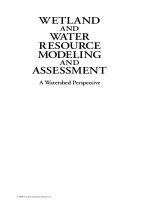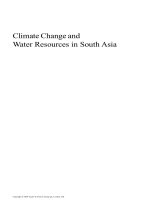chapter 1 Globalization and International Linkages
Bạn đang xem bản rút gọn của tài liệu. Xem và tải ngay bản đầy đủ của tài liệu tại đây (382.45 KB, 33 trang )
chapter one
Globalization and
International Linkages
Chapter 1: Globalization and
International Linkages
The specific objectives of this chapter are:
1. ASSESS the implications of globalization for
countries, industries, firms, and communities.
2. REVIEW the major trends in global and
regional integration.
3. EXAMINE the changing balance of global
economic power and trade and investment
flows among countries.
4. ANALYZE the major economic systems and recent
developments among countries that reflect those
systems.
International Management
International management process:
Applying management concepts and techniques
in a multinational environment;
Adapting management practices to different
economic, political, and cultural environments.
Multinational corporation (MNC):
Operations in more than one country
International sales
Nationality mix of managers and owners
The World’s Top Nonfinancial MNCs from
Developed Countries
(ranked by foreign assets, 2004)
The World’s Top Nonfinancial MNCs from
Developing Countries
(ranked by foreign assets, 2004)
Globalization and
Internationalization
Globalization: the process of integration
among countries around the world with a
vision of a single market entity:
Social Economic Political Technological
Cultural
Internationalization: the process of a
business crossing national and cultural
borders.
Globalization: Pros and Cons
Benefits of Globalization:
wealth, jobs, technology, lower prices.
Criticisms of Globalization:
off-shoring of business service jobs to lowerwage countries;
growing trade deficits;
slow wage growth;
environmental and social impacts.
Global and Regional
Integration:
Global Agreements:
World Trade Organization (WTO)
(General Agreement on Tariffs and Trade
(GATT))
Regional Agreements:
North American Free Trade Agreement (NAFTA)
U.S.-Central American Free Trade Agreement
(CAFTA)
European Union (EU)
Association of Southeast Asian Nations (ASEAN)
Free Trade Agreement of the Americas (FTAA)
International Economic Power in
the Global Economy:
Shifting landscape due to:
Economic integration
Economic potential of emerging
markets
The World’s Largest Economies 2005 and 2020
(Projected) Measured by GDP at Market Exchange
Rates:
The World’s Largest Economies 2005 and 2020
(Projected) Measured by GDP at Purchasing Power
Parity (ppp)
Most Populous Countries in
1980, 2000, and 2050
(Projected):
Trends in International
Investments and Trade:
International Investments:
80% from developed countries
Foreign direct investment (FDI)
Growing at healthy rate
Outpacing domestic growth in most countries
International Trade:
Over ½ of world trade accounted for by United
States, European Union and Japan
Increased substantially over last two decades
Trade Flows Among World Regions, 2005
(in billions of dollars or percent)
World Foreign Direct Investment
Inflows (in millions of dollars):
World Foreign Direct Investment
Outflows (in millions of dollars):
Economic Systems of the
World:
Market Economy
Command Economy
Mixed Economy
Economic Performance
by Major World Region:
North America
South America
Europe (EU, Central and Eastern Europe)
Asia (Japan, China, emerging markets of
Asia)
Other developing and emerging countries
(India, Middle East, Central Asia, Africa)
Economic Performance:
North America
North America:
Free market base economy in region
Combined purchasing power of U.S., Canada and Mexico
approaches $12 trillion in purchasing power
Foreign MNC’s find U.S. to be a lucrative market
United States:
Foreign MNC’s find U.S. a lucrative expansion
market
Foreign firms welcomed as investors in U.S. market
U.S. firms hold market dominance in many
European markets; gaining market share in Asia
Economic Performance:
North America (continued):
Canada:
U.S.’s largest trading partner
Most of the largest foreign-owned Canadian companies
are totally or heavily U.S.-owned
Legal and business environment in Canada is similar to
that in U.S.
Mexico:
Strongest Latin American economy
Very strong maquiladora industry
Trade with both Europe and Asia has increased
Now competitive with Asia for the U.S. market
Economic Performance:
South America
South American countries have accumulated
heavy foreign debt and experienced severe
inflation
Major development is inter-country trade,
including free market policies among South
American countries
South American countries increasingly
looking to do business with U.S.
Economic Performance:
European Union
Privatization of traditionally nationalized industries
Emergence of the EU as an operational economic
union
Economic linkages between the EU and newly
emerging Central and Eastern European countries
Challenge is to absorb former communist bloc
countries
Foreign MNCs gain foothold in EU by:
Acquisitions, Alliances, Cooperative R&D efforts
Economic Performance:
Central and Eastern Europe
Russia, Czech Republic, Hungary, Poland:
Dismantling of Russian price controls
Perestroika—economic and political restructuring
Privatization
Inflation
Crime
Membership in International Monetary Fund (IMF)
Political uncertainty
Economic Performance:
Asia
Japan
Phenomenal economic success in 1970s and 1980s
Ministry of International Trade and Industry (MITI)
Keiretsus
Vertically integrated industries
Holdings provide assistance needed in providing goods and
services to end users
Decade long recession in 1990s
Bank loans backed by real estate or projected revenues
By 2000, most major banks had billions of dollars in
uncollectible loans
International competition has increased
Economic Performance:
Asia
China
Annual real economic growth of 10 percent during the
1980’s and early 1990’s
More recent growth of 8 percent or higher
Healthy and growing economy
GDP growth of 11.1 percent in 1st ¼ of 2007
Attractive to foreign investors despite major political
risk
Product pirating is a major problem
Complicated and high-risk venture









